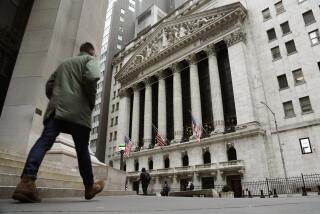Wholesale Prices Soar, Rattle Markets
- Share via
Wholesale prices flared in October as a spike in energy and food costs triggered the biggest monthly increase in wholesale price inflation in more than 14 years, the government said today.
The much larger than expected 1.7% increase in the Producer Price Index rattled financial markets and helped send the Dow Jones industrial average down more than 60 points to close at 10,487.65. Many investors were concerned that any sign of renewed inflation might prompt the Federal Reserve to raise interest rates more aggressively to keep prices in check.
While investors fretted over the Labor Department’s PPI report, which reflects prices paid by manufacturers for materials, most analysts expressed less concern. Many noted that energy and food prices have probably peaked and are expected to moderate in the months ahead.
Steven Wood, an analyst for Insight Economics, said that “prices for both [energy and food] have already begun to retreat.”
“Although core producer inflation has been high in recent months, its year-on-year growth has settled into a range that [Federal Reserve leadership] is likely to be comfortable with,” Wood said.
The 1.7% gain in the October PPI index followed a 0.1% rise in September and a 0.1% decline in August, according to the Labor Department.
Not surprisingly, a run up in gasoline and crude oil prices were responsible for much of the gain, with energy prices in general rising 6.8% in October. Gasoline prices alone leaped 17.3% in October, following an 0.7% decline in September.
Food prices rose 1.6% in October. Analysts blamed hurricane-related disruptions for triggering a 34.2% jump in the price of vegetables.
However, when excluding food and energy costs, wholesale prices rose only 0.3%, the Labor Department said.
Analysts said that it will be difficult for businesses to pass along much of the surge in October wholesale prices to consumers. As a result, many businesses will have to cut other costs, including labor, to handle the jump in the price of energy and other materials.
“Higher energy prices will still mostly serve to compress profit margins and to spur continued cost cutting elsewhere,” said economist Joshua Shapiro at MFR, a New York-based economic consulting firm. The “elsewhere” for cost cutting “tends to fall on the shoulders of workers,” Shapiro said.
The October report on consumer price inflation will be released tomorrow.
More to Read
Inside the business of entertainment
The Wide Shot brings you news, analysis and insights on everything from streaming wars to production — and what it all means for the future.
You may occasionally receive promotional content from the Los Angeles Times.










